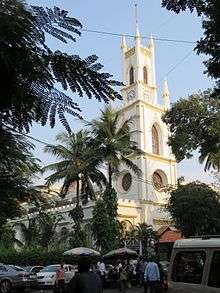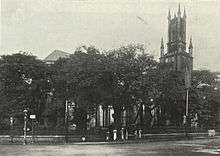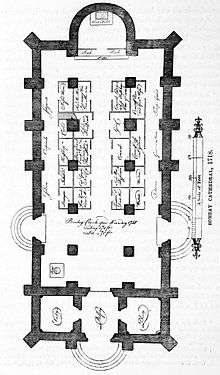St. Thomas Cathedral, Mumbai
| St Thomas Cathedral | |
|---|---|
| Cathedral Church of St Thomas the Apostle | |
| Location |
Horniman Circle, Fort, South Mumbai, Maharashtra |
| Country | India |
| Denomination | Church of North India |
| History | |
| Consecrated |
1718 (298 years ago) & 1837 (renovation & expansion) Bombay, British India |
| Associated people |
British East India Company Monarchy of Great Britain |
| Architecture | |
| Heritage designation | UNESCO Asia-Pacific Heritage Conservation Award |
| Groundbreaking |
1676 (340 years ago) |
| Completed |
1718 1837 (Enlarged) |
| Specifications | |
| Capacity | 1200+ |
| Number of towers | 1 |
| Administration | |
| Deanery | The Cathedral & John Connon School |
| Diocese | Diocese of Mumbai of the Church of North India |

St. Thomas Cathedral, Mumbai, is the cathedral church of the Diocese of Mumbai of the Church of North India. Named in honour of Saint Thomas the Apostle, the Cathedral is located in the historic centre of Mumbai - Horniman Circle and is close to Flora Fountain and Bombay House.
The 298 year old church is controlled by The Cathedral & John Connon School.
The foundation stone of the church was first laid in 1676, although the church was only finally consecrated for divine service 1718 as the first Anglican church in Mumbai (then called Bombay), within the walls of the fortified British settlement. The Cathedral then lead to the creation of The Cathedral & John Connon School in 1860; in order to provide choristers to the church. The Cathedral is a landmark in South Mumbai and is one of the oldest churches in India. It is used by the school for its Founder's Day Service, Christmas Service and other special occasions.
History



The name of nearby Churchgate station refers to this church. One of the gates in the Fort which the East India Company had built to protect their settlement was the entrance to the St. Thomas Church. It was called Churchgate. That is why the whole area towards the West of the Church is called “Churchgate” even today. The street leading to the Church was originally called Churchgate Street and has been more recently renamed (like many streets in Bombay) and is now known as Veer Nariman Road.
The island of Bombay which was a Portuguese possession became a part of the dowry of the Portuguese princess Infanta Catherine of Braganza on her marriage to Charles II of England under the Anglo Portuguese treaty of June 1661. In 1668 King Charles transferred it to the East India Company for a loan of pounds Sterling 50,000 at 6% interest and with a rental of pounds Sterling 10 per annum.
Gerald Aungier was placed in charge of the British East India Company's newly acquired factories at Surat and Bombay, which had until then belonged to Portugal. As Governor of Bombay from 1672—1677, Angier built a church, a hospital, a court of justice and other civic amenities on the English model, and fortified the Company's commercial establishment.[1] The foundation stone for the church was laid in 1676, on Bombay Green, at the present site of the St. Thomas' Cathedral, but over 40 years elapsed before construction could be completed. Richard Cobbe, the Chaplain, completed the construction of the building between 1715 and 1718. It was opened for divine service on Christmas Day 1718, and since then has served continuously as an Anglican place of worship.[2][3]
The church was consecrated as a cathedral in July 1837 concurrent with the appointment of the first Bishop of Bombay, Thomas Carr. The tower and the clock at the western end were added in 1838. About 25 years later a major renovation scheme was launched to enlarge the chancel. This was completed by 1865.
Memorials
The Cathedral contains many carved stone memorials from the eras of Company rule in India and the British Raj. Significant among this number:
- recumbent effigy of Rt. Revd. Thomas Carr, First Bishop of Bombay by British sculptor Matthew Noble.
- memorial to Rear Admiral Sir Frederick Lewis Maitland
- memorial to Captain George Nicholas Hardinge
Current
After completion of a major restoration work the cathedral was selected in 2004 for a UNESCO Asia-Pacific heritage conservation award.[4]
The current congregation at St. Thomas Cathedral is led by Rev. Avinash Rangayya.
Gallery
.jpg) St. Thomas Cathedral, interior, nave
St. Thomas Cathedral, interior, nave.jpg) St. Thomas Cathedral, interior, chancel
St. Thomas Cathedral, interior, chancel Stained glass window of St. Thomas Cathedral
Stained glass window of St. Thomas Cathedral
See also
References
- ↑ J. L. Mehta, Advanced study in the history of modern India 1707-1813, Sterling Publishers (2005), p. 338. ISBN 1-932705-54-6
- ↑ Richard Cobbe, Bombay church: or, A true account of the building and finishing the English church at Bombay in the East Indies, London, John Rivington (1766)
- ↑ "About Us", St. Thomas Cathedral website
- ↑ UNESCO Bangkok, "Asia-Pacific Heritage Awards for Culture Heritage Conservation"
External links
- St. Thomas Cathedral website
- "St. Thomas' Cathedral", Maharashtra State Gazetteer: Greater Bombay District (1986-7; online, 2007)
- 360° panorama of the interiors of St Thomas Cathedral
Coordinates: 18°55′54″N 72°50′1″E / 18.93167°N 72.83361°E